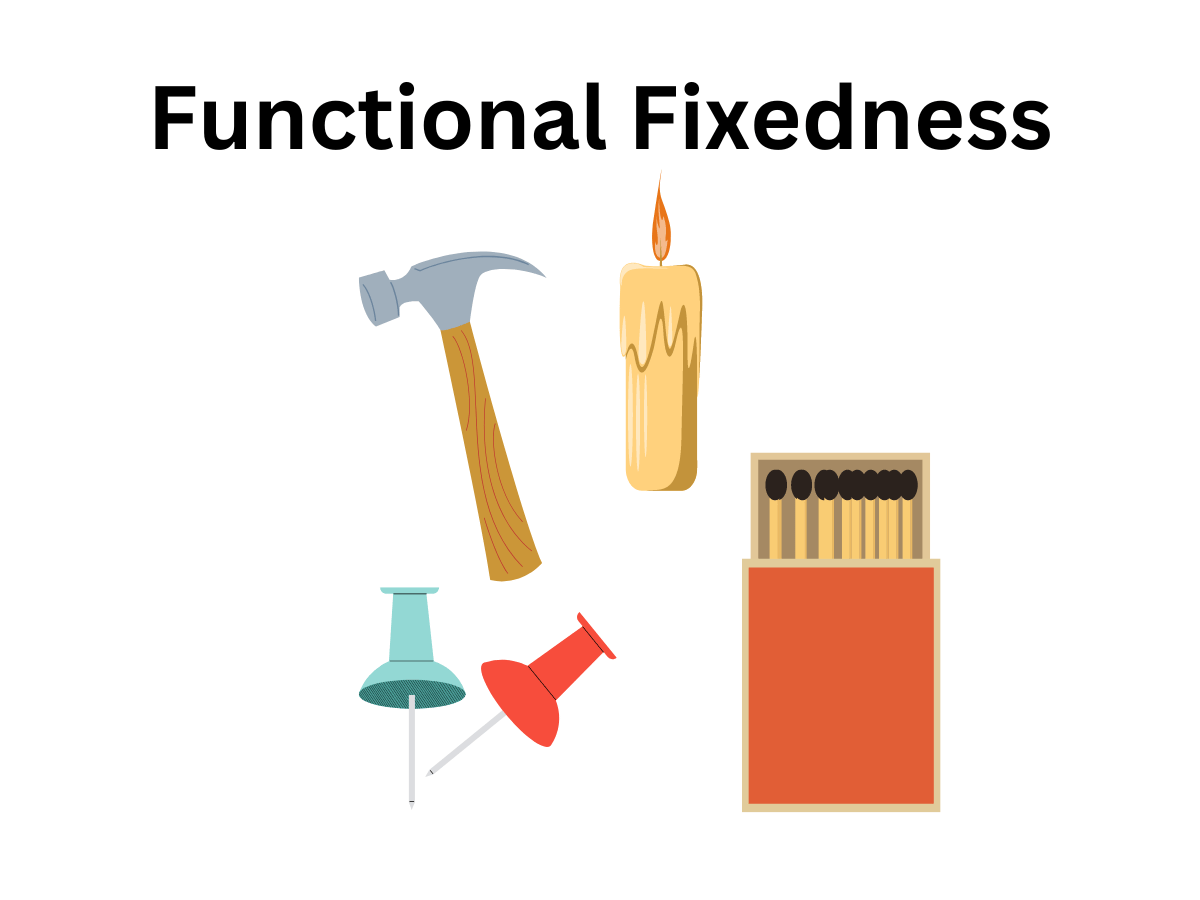What Is Functional Fixedness in Psychology?
Functional fixedness is when people can only think of traditional ways of using objects. It is a type of cognitive bias that prevents people from thinking outside of the box and developing creative solutions. When you have a particular tool, you might look at it in terms of how it is traditionally used. A screwdriver,…

Functional fixedness is when people can only think of traditional ways of using objects. It is a type of cognitive bias that prevents people from thinking outside of the box and developing creative solutions.
When you have a particular tool, you might look at it in terms of how it is traditionally used.
A screwdriver, for example, is for loosening or tightening a screw. But you might also use a screwdriver as a chisel, pry bar, hole punch, or scraper.
Functional fixedness might prevent you from thinking of other ways to use such tools and objects to achieve your goals and reach novel solutions.

How Functional Fixedness Works
Functional fixedness limits a person’s ability to come up with novel solutions for ways to use familiar objects. Instead of thinking about all of the ways that an object could be used, this bias leads people to focus on the ways that it is traditionally utilized.
Because of this focus on typical uses, a person might miss other solutions. This can create obstacles to effective problem-solving. Instead of being able to look beyond the way things are usually done, people get stuck in old patterns and ways of thinking that hold them back and prevent innovation.
Examples of Functional Fixedness
Functional fixedness is a cognitive bias that limits a person to using an object only in the way it is traditionally used. In psychology, some examples of functional fixedness include:
Candle Problem
In this classic example of functional fixedness, people are given a candle, matches, and thumbtacks. They are then tasked with attaching the candle to a wall to be lit without dripping wax onto the floor.
The solution is to empty the box of matches and use the matches to melt the bottom of the candle and stick it to the bottom of the box. Then, tack the box to the wall with the thumbtacks and use it as a candle holder. However, because of functional fixedness, people often only see the box as a container for the matches.
Two String Problem
Another example of functional fixedness is known as the two string problem. People are given two strings hanging from the ceiling and are tasked with tying them together. The strings are far enough apart that a person cannot reach both at the same time. However, people are also given other objects, such as pliers and a hook.
People with greater functional fixedness might struggle to see that they can tie one string to the pliers and swing the string, allowing them to grab the other string and then catch the other string in their opposite hand when it swings back toward them.
What Causes Functional Fixedness?
There are a variety of cognitive factors that can contribute to functional fixedness.
Perceptual Set
Perceptual set refers to the tendency to perceive certain aspects of a stimulus while ignoring others. Our perceptions of objects are heavily influenced by our expectations that past experiences have shaped. Because of this, we often see objects in terms of their familiar uses.
Inflexible Thinking
People who lack cognitive flexibility may struggle with rigid thinking patterns. This can make it difficult to approach problems creatively.
Stimulus Modality
Researchers have found that how information is presented can impact functional fixedness. When people encounter a picture of an object, they are more likely to try to reproduce those images when engaging in creative tasks, even if they don’t lead to the best results.
On the other hand, people who just see the names of the objects are more likely to come up with more creative solutions that are less influenced by functional fixedness.
What Are the Effects of Functional Fixedness?
Functional fixedness can have a negative impact on problem-solving and decision-making. Some potential challenges it might create include:
Poor Problem-Solving
Because functional fixedness limits your options, you’re less likely to come up with alternative solutions to problems. For example, if you are trying to pry something open but don’t have a pry bar, you might not recognize that a hammer could also be used for such a purpose because you are thinking of it only in terms of its traditional use.
Lack of Innovation and Creativity
When your thinking is fixed in a certain pattern, it’s much harder to think creatively. This can hinder your progress and lead to a lack of innovation.
Poor Use of Resources
Only using things based on their expected or traditional use can lead to inefficiency and waste. Because you’re overlooking alternative uses, you might spend more on materials or objects that you don’t actually need.
Missed Opportunities
Because functional fixedness limits improvement, people may miss out on opportunities to optimize their situation. Instead of succeeding in a task and moving forward, they stay stuck on the same problem for too long.
It’s important to recognize that functional fixedness isn’t always a bad thing. Sometimes, it helps people solve problems more efficiently in ways that often work as expected. Recognizing when this cognitive bias might be holding you back (and taking steps to minimize it) can help ensure that it doesn’t hinder your creativity or problem-solving abilities.
How Can You Avoid Functional Fixedness?
Some research suggests that inaccurate knowledge about how tools work can contribute to functional fixedness. The same study suggested that while functional fixedness can make problem-solving more difficult, developing better problem-solving skills can help people get around it.
In order to avoid functional fixedness, it is important to become more aware of it and take steps to consciously think more outside the box.
Brainstorm Alternatives
Break the problem down into its most basic elements and then brainstorm possible solutions. Let your imagination run, and think up as many creative ideas as you can. Once you’ve come up with some ideas, look at them with a critical eye to consider which ones might be the most viable.
Seek Differing Viewpoints
Talk to people with different backgrounds and experiences to learn more about how they might approach the problem. Consider collaborating with groups of people who can bring differing types of expertise to the table. This can help promote new ideas and fresh insights you might not have considered otherwise.
Practice Mindfulness
Becoming more aware of your own preconceptions and assumptions can also be helpful. Work on becoming more mindful and aware of your own thinking patterns and how your emotional states might influence your choices and decision-making.
Foster Curiosity
Try to keep an open mind about new ideas. Ask questions and think about how some of these new ideas might contribute to your own problem-solving and decision-making strategies. This can help build greater cognitive flexibility, which will ultimately help reduce functional fixedness.
Look at Mistakes as Learning Opportunities
Remember that mistakes can be informative. Don’t hold back from trying new things. Instead, give yourself the freedom to experiment with creative solutions, and remember that you can always try again if things don’t go as expected.
Key Points to Remember
- Functional fixedness is a cognitive bias where a person’s previous knowledge of how an object typically functions limits how they might use it in different situations.
- It can negatively affect problem-solving by restricting how people use tools or objects in novel situations.
- Past experiences, cognitive inflexibility, and stimulus modality can all contribute to functional fixedness.
- To overcome functional fixedness and improve problem-solving, people can brainstorm alternative solutions, seek diverse perspectives, build self-awareness, foster creativity, and learn from mistakes.
Sources:
Chrysikou, E. G., Motyka, K., Nigro, C., Yang, S. I., & Thompson-Schill, S. L. (2016). Functional Fixedness in Creative Thinking Tasks Depends on Stimulus Modality. Psychology of Aesthetics, Creativity, and the Arts, 10(4), 425–435. https://doi.org/10.1037/aca0000050
Ibáñez de Aldecoa, P., de Wit, S., & Tebbich, S. (2021). Can habits impede creativity by inducing fixation? Frontiers in Psychology, 12, 683024. https://doi.org/10.3389/fpsyg.2021.683024
Kroneisen, M., Kriechbaumer, M., Kamp, S. M., & Erdfelder, E. (2021). How can I use it? The role of functional fixedness in the survival-processing paradigm. Psychonomic Bulletin & Review, 28(1), 324–332. https://doi.org/10.3758/s13423-020-01802-y
Munoz-Rubke, F., Olson, D., Will, R., & James, K. H. (2018). Functional fixedness in tool use: Learning modality, limitations and individual differences. Acta Psychologica, 190, 11–26. https://doi.org/10.1016/j.actpsy.2018.06.006





